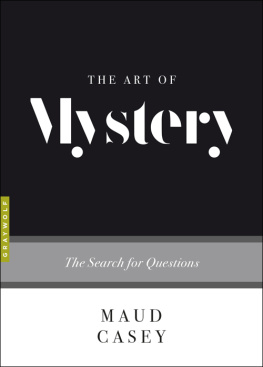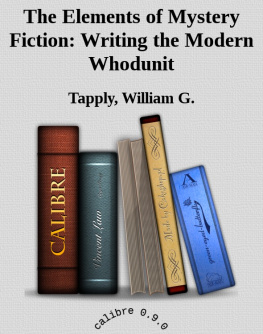The Art of
MYSTERY
THE SEARCH FOR
QUESTIONS
Maud Casey
Graywolf Press
Copyright 2018 by Maud Casey
The author and Graywolf Press have provided this e-book to you for your personal use only. You may not make this e-book publicly available in any way. Copyright infringement is against the law. If you believe the copy of this e-book you are reading infringes on the authors copyright, please notify Graywolf Press at: us.macmillanusa.com/piracy.
This publication is made possible, in part, by the voters of Minnesota through a Minnesota State Arts Board Operating Support grant, thanks to a legislative appropriation from the arts and cultural heritage fund, and through a grant from the Wells Fargo Foundation Minnesota. Significant support has also been provided by Target, the McKnight Foundation, the Lannan Foundation, the Amazon Literary Partnership, and other generous contributions from foundations, corporations, and individuals. To these organizations and individuals we offer our heartfelt thanks.

Published by Graywolf Press
250 Third Avenue North, Suite 600
Minneapolis, Minnesota 55401
All rights reserved.
www.graywolfpress.org
Published in the United States of America
Printed in Canada
ISBN 978-1-55597-794-8
Ebook ISBN 978-1-55597-985-0
2 4 6 8 9 7 5 3 1
First Graywolf Printing, 2018
Library of Congress Control Number: 2017937995
Cover design: Scott Sorenson
It is strange to be here. The mystery never leaves you alone .
John ODonohue
THE ART OF MYSTERY
THE SEARCH FOR QUESTIONS
The Land of Un
A few summers ago, I found myself pushing through hot, thick New York City air on Twenty-Third Street in Chelsea. I was on my way to be hypnotized. It was a pivotal point in my lifea long relationship was ending; life was supposed to have gone one way and it was about to go somewhere else entirely; there was about to be sadness, anger, guilt, the sensation of teetering on the edge of the earth with the possibility of, at any time, spinning off into the ether. The usual fare.
I was on my way to be hypnotized, and photographed in that hypnotic state. A friend of a friend, a photographer whose work I admired, was working on a project that involved photographing people for whom imagination plays a central roleartist, dancer, writer types. My friend had offered my name; at the time, I was working on a novel inspired by a nineteenth-century French psychiatric case study, which involved hypnosis, the medical intervention du jour, and the birth of photography as, among other things, a forensic tool for reading illness and criminality on the body. The photographer asked me to bring an important moment from my life, something to help focus me while being hypnotized. What felt most lacking in my life right then was wonder, and so I brought with me, like an ice cube in danger of melting in my hand before I arrived at the photographers studio, my first memory of wonder.
In the very hot heat of the moment, jostling and being jostled by a sidewalk full of people with their own concerns, I felt that my concerns had shrunk themselves to this question: What if Im one of those people who cant be hypnotized? When I arrived at the photographers studio, while the photographer set up her tripod and the hypnotist explained the logistics in his deep and deeply soothing voice and I grew suspiciously drowsy, my concern suddenly flipped: What if I was so suggestible that I might be hypnotized before we even began? What ultimately happened lay somewhere in between resistance and submission; what happened was something that to this day I am unable to explain entirely.
I might begin, however, by telling you that my first memory of wonder is an impromptu camping trip in a Rhode Island pine forest, not far from the ocean, not far from where my family was living at the time. That it was possible my parents had been fighting (they were divorced not long after) and that, indeed, there was something fraught about my mother taking just us kids to the woods. That when we arrived in the woods, there was the sweet smell of pine and the sharp smell of ocean salt and in the distance the sound of crashing waves. That I was a painfully shy kid who spent much of her time willing invisibility around her like a cloak in the midst of a raucous bohemian family that occasionally lit itself on highly visible, glorious fire. That once night fell, it became so dark that the waves seemed to crash out of the darkness itself. What I felt then was part innocence, part terror, part awe. Something was revealed; something laid bare. It was to this wondrous place that I went under hypnosis.
I might also explain that I never completely lost the awareness of the photographers studio, of the hypnotist, the photographer and her assistant. Even with my eyes closed, I could feel the hot flash of the bulb on the vintage tripod camera. I was, at once, performing and being magically transported to that place in the woods, a place, I would realize later, to which Im transported on good days when I write. I might explain that I felt like myself and utterly unlike myself. I might try to explain all of these things, and I still wouldnt have gotten to the bottom of the experience. An experience I think about still, one I could think about endlessly. What was that?
We fiction writers talk a lotfor good reason, and to good endabout character, point of view, dialogue, scene, and summary, but in my experience, we dont talk a lot about mystery. Its not easy to talk about something that is a whispered invitation, a siren song, a flickering light in the distance. Its not easy to talk about something that, even as it encourages us to seek it, resists explanation. Something that wafts like smoke around the edges of the page. Especially when there is, in our culture, an increasing intolerance for ambiguity, for Keatss famous negative capability, in which, as he wrote, one is capable of being in uncertainties, Mysteries, doubts, without any irritable reaching after fact and reason.













